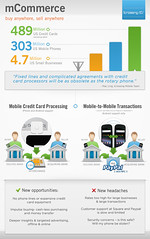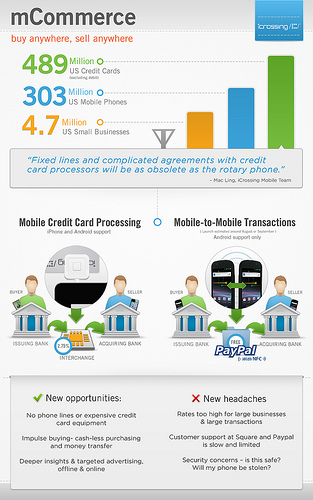What is mCommerce all about?

The Internet revolutionised the way people shop. Customers get the same great products at a reduced price from the comfort of their sofa, and opening hours are a thing of the past. It has given retailers incredible power to overcome the biggest hurdle in growing their business: geographical limitations. This created a radical shift from local providers to specialist providers. Retailers were given the freedom to find a niche and own it, from anywhere in the world. There is mass adoption of smartphones, which gives retailers a new opportunity to reach customers. These customers are no longer limited to shopping from their desks and sofas, they now have smartphones which spend every waking hour in either their palm or their pocket.
This new opportunity comes with new set of challenges. How can retailers meet these challenges? Will the same retailers who benefited from the Internet revolution see big gains from mobile commerce?
This article explores the opportunities and challenges in mCommerce for retailers.
What is mCommerce?
mCommerce (short for Mobile Commerce) refers to a transaction where the customer uses a mobile device to complete the transaction. It can refer to both virtual and physical goods though we’ll just consider physical goods in this article.
Completing a transaction using a mobile device can be done in several ways, here are some examples:
- Using a mobile website with an eCommerce system
- Using a mobile app with an integrated payment system
- Using NFC (Near Field Communication)
- Using a premium rate SMS service
Why should retailers care?
Every day the number of mobile and tablet devices with sophisticated mCommerce capabilities is increasing. Recent statistics show that consumers are spending more time using apps than mobile and desktop internet combined!
This illustrates that in order to get in front of consumers, retailers must have an mobile strategy. Specifically retailers need to find an effective mCommerce strategy.
The first option for retailers is to have a mobile-optimised website. This ensures that consumers see a well formatted website consistent with their in-store and online experience. However, as I discussed in the Mobile site vs. mobile app article, this may not be enough.
What are the options?
For online-only retailers…
Don’t bother with apps. If all of your custom is based on online traffic, a pure mCommerce app is unlikely to make a big difference. You are much better off making a mobile optimised site. The only exception here is if you are very large. If that’s the case, you have an opportunity to be a little sneaky. Create an app with a barcode reader so you can capture sales while people are browsing products in other real-world stores!
For small chains with an online offering…
Make a mobile optimised eCommerce site, and consider an out-of-the-box mCommerce app, an example is FactoryFront a startup idea I started. Independents and small chains can also benefit from the location elements of social networks such as Foursquare and Facebook.
For retail chains…
Make a mobile optimised eCommerce site, and an mCommerce app. With a chain of stores, mobile apps are very attractive. There are two or three really powerful features that come into play here.
The first is a store locator, this gives your best customers an easy way to find your stores in unfamiliar places. This only makes sense for retail chains. Retailers with only a handful of locations are probably too locally focused for this to be useful. I think the lower bound here is ten locations.
The second is a loyalty feature. By building a loyalty programme into the app you have a point of interaction where you can prompt users to complete certain actions such as completing surveys, or sharing information via social media. You could also target your best customers for special promotions.
The third key feature is taking payment. A great example of this is the Pizza Express app
which uses integration with Paypal so visitors to the restaurant can even pay their bill through the app!
Whatever you make, make it useful
The key message is that as a retailer you have to consider mobile devices as a marketing channel and sales channel. To benefit from mobile devices fully, make an application or website that is useful for consumers and makes it easier for them to buy from you. If you do that, you’re sure to see an uplift in sales.
Related articles
- Should you make a mobile site, or a mobile app? (thestartupmag.com)
- Introduction to mobile marketing (thestartupmag.com)
- How to create a successful online store, by Curio Threads (thestartupmag.com)

